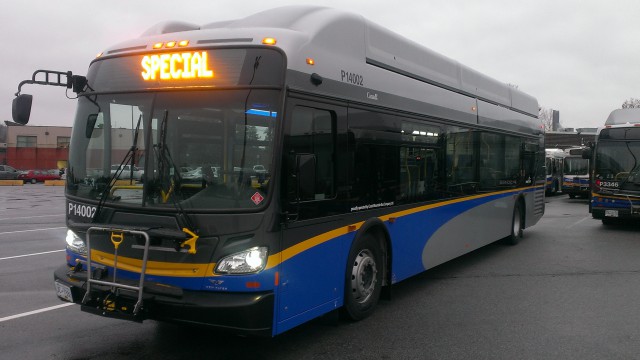Take transit in Port Coquitlam? You might have spotted our new CNG buses!
Take transit in Port Coquitlam? You might have spotted our new CNG buses!

If you take transit in Port Coquitlam and neighbouring cities, you might have spotted our new compressed natural gas buses in service! Coast Mountain Bus Company will be receiving 45 of these New Flyer Xcelsior buses in total.

Passengers will notice the roof of the bus is higher and the European-style windows outside, which are flush with the side of the bus. In the interior, courtesy screens have been added in front of the first forward sitting seats on both sides. There’s also a rear-facing wheelchair seat like our trolley buses and Nova Buses.
The rear roof hatch is now a sun roof and the bus has climate control set for 20.5°C, so you’ll want to keep the sun roof and windows closed. Having it open during the winter months can cause rain and snow to enter vehicles too!
Expect a smoother, more comfortable and powerful ride too. Transmission shifting is a lot smoother and comments from drivers and passengers are that the bus seems to glide. The bus also has more power, so it will be able to climb hills such as Gaglardi Way up to Simon Fraser University with a little more ease.
The buses will operate out of Port Coquitlam Transit Centre as it is currently the only centre equipped with CNG refueling stations until the Hamilton Transit Centre in east Richmond opens in 2016.
Renewing our bus fleet is part of our commitment to keep our system in a state of good repair. Most of our 40-foot and 60-foot buses have a 17-year replacement life as this life cycle has proven to have the lowest overall cost and practical life for our fleet. After 17 years, the costs to maintain vehicles increases and the safety decreases due to factors such as:
- Component obsolescence – for example, the engines in our older buses have been out of production for 14 years.
- Frame and body corrosion and fatigue – structural repairs can be very expensive or not safe to repair.
- Overall maintenance costs escalate and reliability is lower as components reach the end of life and/or are rebuilt multiple times.
- Safety inspections often take a bus out of service around the 17 year life.
- Environmental and comfort factors – older buses have much more emissions, and are generally noisier, plus possible less comfort for passengers and drivers.
The 45 new CNG buses will replace the 45 older diesel buses that have reached the end of their life and will be retired from service.
Thanks to Eric W. for suggesting this Buzzer blog post! Have something you’d like us to blog about? Email it to thebuzzer@translink.ca or tweet us @TheBuzzer.
Author: Allen Tung






Which buses will be retired from service this time? Don’t these buses also have the same sun roof and european style windows as the Richmond Xcelsior Hybrid Articulated buses?
I’ve read in various online news articles that Surrey Transit Center was under consideration for a CNG fueling station, have there been any decisions made in relation to that?
Also, if Translink decides to go ahead with the options on the contract for 51 buses in 2015 and 84 buses in 2016, do you have any idea which transit centers they will go to and if they will be CNG or diesel?
Ric: We are retiring the older D40LF buses. These buses have the same sun roof as the Xcelsiors in Richmond.
How is braking with these coaches?
I have found that buses with ZF transmissions usually brake rougher and more uncomfortable than buses with Allison transmissions because of the retarder.
Ric: The oldest low floors, the 7100’s and some of the 7200’s are being replaced…
As PoCo gets the new 14000’s, then older 7300’s and 7400’s are being moved to Richmond, and other depots, to help retire the oldest 7100’s and 7200’s…
Have noticed that the Community Shuttles aren’t kept for as long as the regular buses. Any reason for that?
I like those busses and wonder will surrey get nova or other new busses since they mostly get old ones and if surrey be like vancouver will they have more routes